Next time you drop rubbish on the ground, it could end up killing a bird in its own nest.
Heartbreaking photos and video footage reveal white storks – one of Europe’s biggest birds – tangled up in plastic waste, rope and other harmful human debris.
Scientists at the University of East Anglia (UEA) say the species, once common in the UK, is harvesting carelessly disposed trash to build their nests.
It is turning their home into a plastic ‘death trap’ – often killing young chicks through limb loss, strangulation, ingestion and more.
The photos, snapped in Portugal, reveal several white stork nests littered with blue rope, plastic bags, wrappers, tissues, fabric and even a soft toy.
White storks are opportunistic foragers when searching for food or building nests, meaning they often end up collecting our junk.
Aldina Franco, a professor in ecology and global environmental change at UAE who took some of these images, said the birds ‘suffer a horrible death’, calling it a ‘serious issue’.
‘These chicks get entangled in synthetic ropes when they are very young and the ropes slowly strangle their limbs as they grow, mostly legs and feet,’ he said.
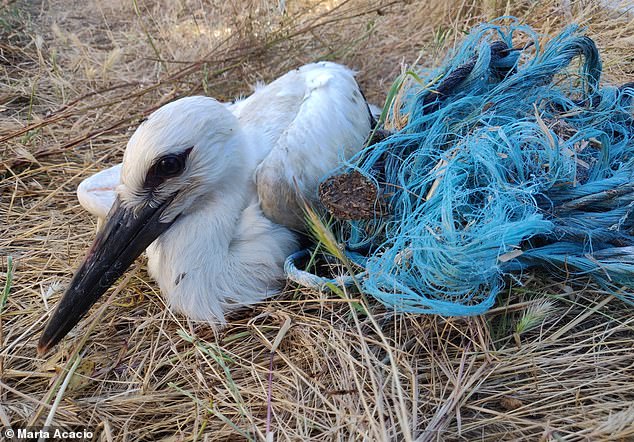
White storks in Portugal are using synthetic materials like plastic and rope to build their nests, the scientists found. Pictured with blue baler twine
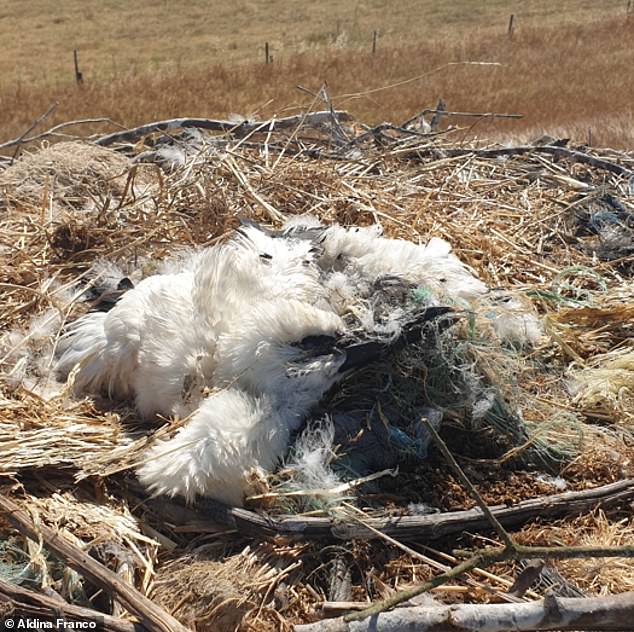
Tragic: A dead white stork chick in its nest due to entanglement. As is happening in the oceans due to human plastic pollution, discarded synthetic materials can be a serious hazard on land too
The UAE scientists worked with colleagues in Portugal to examine the impact of plastics and rope in the nests of white storks there.
They monitored and photographed 32 white stork colonies and 568 nests in Alentejo and the Algarve, southern Portugal, over four years.
Overall, they found human-derived materials present in a whopping 91 per cent of the 568 stork nests monitored during the period.
Soft plastic, like plastic bags, was the most common material, found in 65 per cent of the nests, followed by synthetic ropes (the main cause of entanglement) in 42 per cent of nests.
Baler twine, a slow-degrading polypropylene rope, accounted for 63 per cent of the entanglements and was present particularly in colonies surrounded by agricultural areas.
Overall, white stork chicks in nests containing a higher number of rope material were more likely to become entangled and had lower survival rates.
During one year of weekly checking (2023), 35 out of 290 birds too young to leave their nest (nestlings) became entangled in some type of synthetic material. Many of these nestlings died, often due to injuries such as necrosis (death of body tissue) and limb loss.
Where possible, researchers accessed nests with ladders to free the nestlings from the materials – but many other nests were inaccessible.

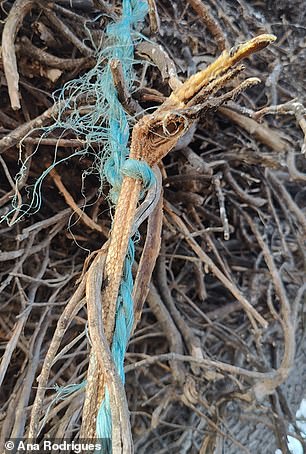
Where possible, researchers were able to access nests with a ladder to free the nestlings from the materials in an attempt to save their lives
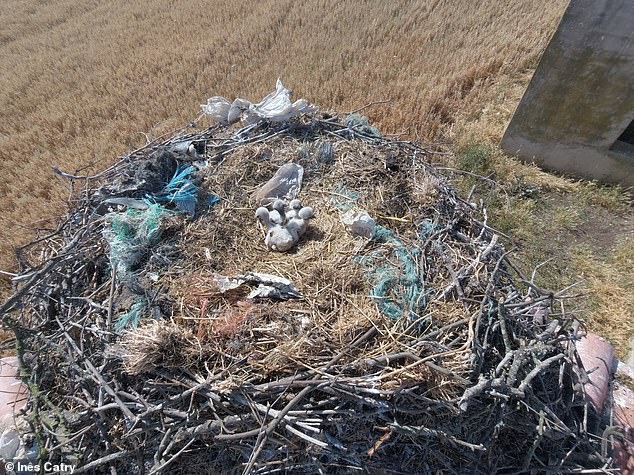
White stork nest with chicks surrounded by ‘anthropogenic nest materials’ (ANMs) – human-made materials like plastic and rope
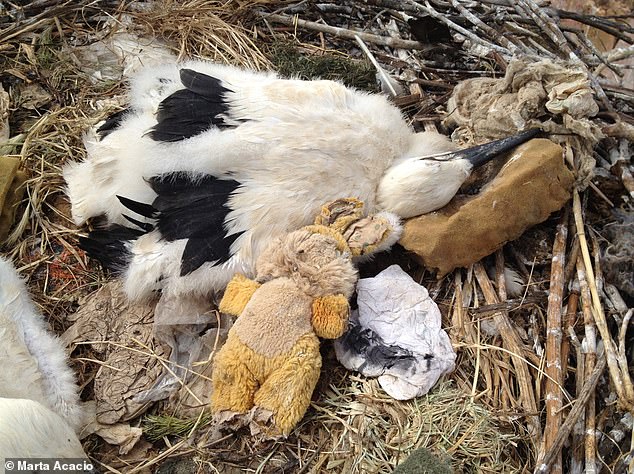
Pictured, a live chick ‘playing dead’, a strategy used by other species as well as a defence mechanism against predators and when humans approach. It’s believed the cuddly toy next to it was brought to the nest by an adult stork
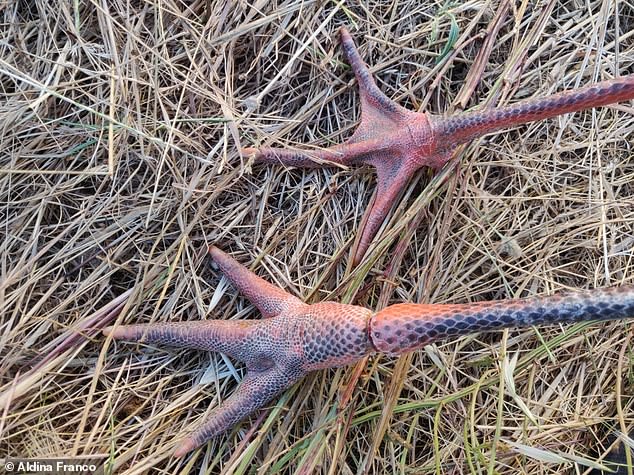
White stork leg has become tangled in tightly-wound fibre, causing pain and leaving a potentially permanent mark. The leg is still swollen from the entanglement
‘In some cases they still died from the consequences of their wounds,’ lead author Ursula Heinze, a postgraduate researcher at UEA, told MailOnline.
The white stork (Ciconia ciconia) has a wide range across Europe, but is clustered in the Iberian Peninsula (Spain and Portugal) and much of eastern and central Europe.
The species – known for clattering their bills as a form of communication – frequently nests near or within human settlements and tends to rely on landfills as foraging grounds.
‘White storks are known to incorporate discarded human-made materials into their nests, frequently nest near or within human settlements and often forage on organic waste at landfill sites,’ said co-author Dr Inês Catry at the University of Lisbon.
‘The reasons for using these materials in nest-building are not fully understood.
‘But they may relate to their availability and the scarcity of natural ones, while some might also be mistaken for food, being inadvertently incorporated in the nests.’
The authors acknowledge that their study, published in the journal Ecological Indicators, only looked at one species in one country.
But they say white stork is an ‘indicator species’, meaning it will reflect a broader trend in the environment – not limited to Portugal.
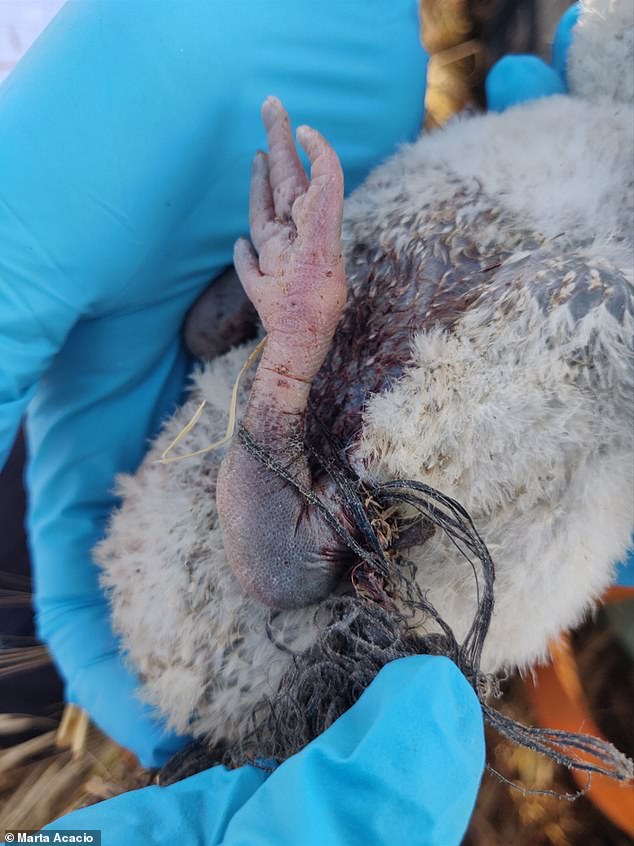
Pictured, entanglement in rope leads to painful lacerations for the white stork, which was once common in Britain
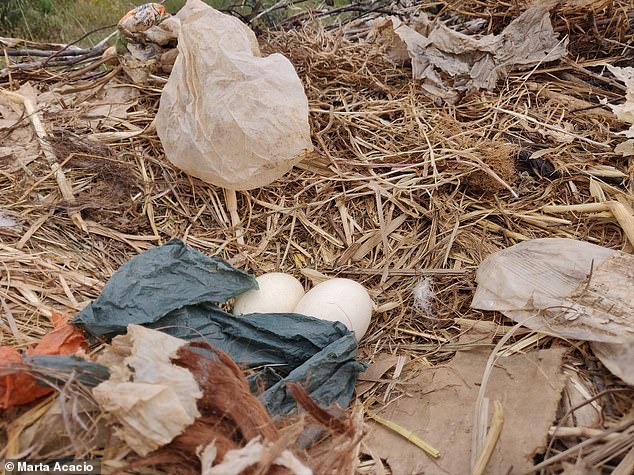
Pictured, a white stork nest with eggs surrounded by plastic, wrappers and other human-caused waste material
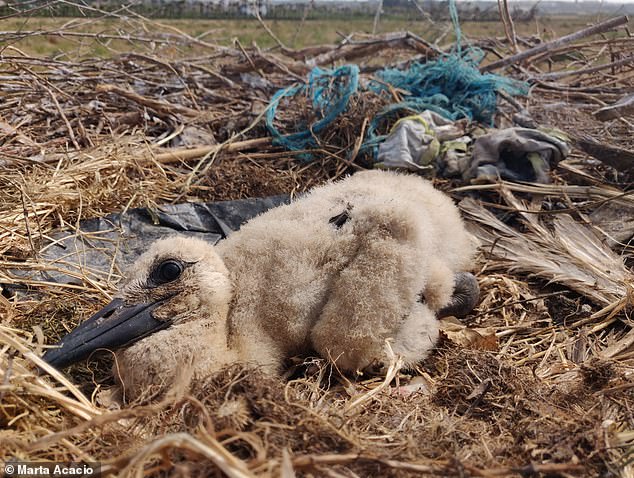
White stork with blue baler twine, a slow degrading polypropylene rope used in agriculture. White storks are opportunistic foragers when searching for food or building nests, meaning they often end up collecting synthetic waste
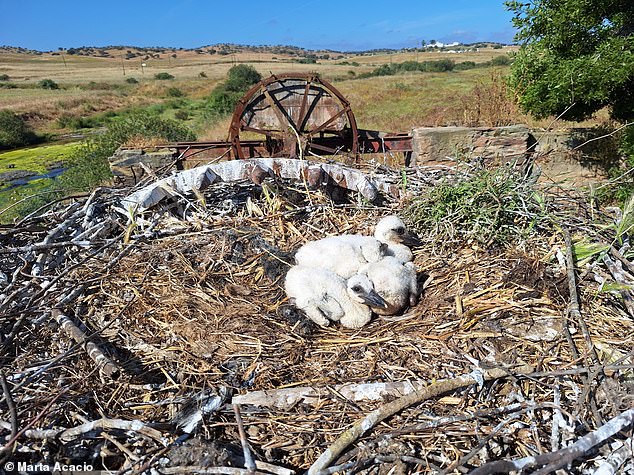
Pictured, healthy chicks in a nest built with no synthetic waste. On land, the incorporation of human-derived materials into bird nests is already well documented
White storks are native to the British Isles and evidence suggests that they were once widely distributed here before their decline, due to factors such as overhunting with guns and habitat loss.
Thanks to reintroduction efforts, white storks are making a comeback in Britain, including at Knepp Estate in Sussex.
The research team, including researchers from the University of Montpellier and University of Lisbon, know pollution like this is widespread – on land and in the sea.
Such materials are also now being found in nests in the UK and other countries, such as Ukraine.
‘In Ukraine, for example, solders are finding nests with fibre optic wires from remote controlled drones,’ said Professor Franco.
‘In the UK, several passerines, such as goldfinches and wrens, have also started using different colour polypropylene threads to build their nests.
‘People spotting empty nests at the end of the breeding season may have started to notice this.
‘Impact of plastic in the nests can be underestimated because the negative effects of human-produced materials tend to happen in the early life of the chicks, at an average age of two weeks, and the deaths can go unnoticed.’











